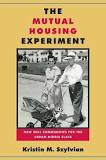The Mutual Housing Experiment: New Deal Communities for the Urban Middle Class

Kristin Szylvian’s research into the United States’ mutual housing associations draws on her dissertation study on Electric Heights – a housing development owned by a mutual housing association – in Turtle Creek, Pennsylvania. This book examines the origins of the Mutual Home Ownership Plan (or Mutual Plan) created by Lawrence Westbrook, and its application in eight pilot projects. These eight pilot projects are found in Texas, New Jersey, Ohio, Pennsylvania and Indiana. The book also seeks to explain why the Mutual Plan was abandoned as the Roosevelt administration prepared for postwar commercial market growth (page 2).
The Mutual Housing Experiment is comprised of seven chapters. Chapter 1 examines President Roosevelt’s New Deal in relation to housing as a response to “the economically distressed non-commercial real estate market” (page 10). In particular it traces the work of Lawrence Westbrook to strengthen the non-commercial housing market through cooperative home ownership, and how this influenced his creation of a mutual housing ownership plan “as an alternative route to federal housing aid” that “could be administered with defense housing funds provided under the Lanham Act” (pages 24–25).
Chapter 2 looks at the involvement of labour in federal housing policy and Westbrook’s collaboration with John Green, who was at the time trying to secure safe and decent homes for his shipbuilding workers in Camden and other coastal cities (pages 27–28). It also notes the creation of the Mutual Ownership Defense Housing Division, which enabled Westbrook to work out the details of the Mutual Plan.
In Chapter 3, Szylvian explores the unintended consequences that Westbrook’s enthusiastic marrying of mutual home ownership and modern architecture had for the Mutual Plan.
Chapter 4 details how enthusiasm for mutual housing spread from the East to the West Coast of the United States during the early 1940s. This was marked by the War Workers’ Housing Conference in 1942, as political parties laid aside their differences to expand the application of the Mutual Plan (page 76). The chapter concludes that resistance to mutual housing consequently arose amongst real estate developers and their political allies, who worried that such support would bring about a broader application of the Plan (page 100).
Chapter 5 looks at how a reorganization of the federal housing bureaucracy in 1942 actually arrested development of the Mutual Plan. This replaced or subordinated New Deal-inspired goals (held by Westbrook and others) with a new breed of housing administrators who found it easier to talk to realtors than union leaders and housing reformists.
In Chapter 6 Szylvian depicts the renewed efforts towards mutual housing upon Westbrook’s return from the Army in 1945, as the US faced a scarcity of affordable housing. She discusses the growth of mutual housing between 1945 and 1949 as Westbrook together with George Creel endeavoured to include mutual housing in postwar plans. Although the Federal Public Housing Administration and issues of racism, segregation and communism thwarted developments, Szylvian identifies a wave of optimism for mutual housing post-1949 as the housing needs of middle-income households moved into national focus.
In conclusion, Chapter 7 examines postwar legislative efforts to develop a cooperative corporation to promote mutual housing, and why they failed (pages 148–149). In the words of Szylvian, this was a missed opportunity when cooperative housing could have been “one of the most effective ways of handling” central city decline and urban sprawl in the US (page 174).
According to the author, revisiting the topic of mutual housing is timely (if not overdue) at a time of widening inequality, especially following the US home mortgage crisis that started in 2008 (pages 3 and 8). She hopes that by reviewing the story of mutual home ownership as an alternative to traditional home ownership, an interest may be ignited “in the Roosevelt administration’s Mutual Plan and inspire development and testing of the next-generation model” (page 8).
Book note prepared by Hannah Keren Lee
Search the Book notes database
Our Book notes database contains details and summaries of all the publications included in Book notes since 1993 - with details on how to obtain/download.
Use the search form above, or visit the Book notes landing page for more options and latest content.
For a searchable database for papers in Environment and Urbanization, go to http://eau.sagepub.com/

